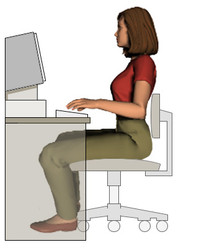“Don’t Sit Up Straight,” Some Experts Are Advising
Posted by Jennifer Anderson on 7th Sep 2017
Almost from childhood, people are told to sit up straight. New research suggests it could be bad advice.
Researchers at Woodend Hospital in Aberdeen, Scotland, found that sitting upright with a straight back and thighs parallel to the floor increases the strain on lumbar discs in the lower back, a prescription for pain. Waseem Amir Bashir, M.B.Ch.B., F.R.C.R, author and clinical fellow in the Department of Radiology and Diagnostic Imaging at the University of Alberta Hospital in Canada, delivered the researchers' findings at the November meeting of the Radiological Society of North America (RSNA) in Chicago.
The RSNA press release said the newly-designed magnetic resonance imaging (MRI) machine the researchers used provides a full view of the back in sitting position. It's a positional scanner, which means patients can be scanned seated or standing. Traditional scanners require patients to lie flat, a position that places different strains on the back and can mask causes of pain associated with varied movements or postures.
The researchers studied 22 healthy volunteers with no history of back pain or surgery. The patients assumed three different sitting positions: a slouching position, in which the body is hunched forward as it can be when a person is working at a desk or playing on a video games console; an upright 90-degree sitting position; and a relaxed position, where the patient reclines backward 135 degrees while the feet remain on the floor. Measurements were taken of spinal angles and spinal disk height and movement across the different positions.
The found that spinal disk movement occurs when weight-bearing strain is placed on the spine, causing the internal disk material to misalign. Disk movement was most pronounced with a 90-degree upright sitting posture. It also revealed a reduction in spinal disk height, signifying a high rate of wear and tear on the lowest two spinal levels.
"A 135-degree body-thigh sitting posture was demonstrated to be the best biomechanical sitting position, as opposed to a 90-degree posture, which most people consider normal," Dr. Bashir reported. The study indicates that less strain is placed on the spinal disks and associated muscles and tendons in a more relaxed sitting position.
Back pain is the most common cause of work-related disability in the United States, and a leading contributor to job-related absenteeism, according to the National Institute of Neurological Disorders and Stroke. By identifying bad seating postures and allowing people to take preventative measures to protect the spine, Dr. Bashir and colleagues hope to reduce back strain and subsequent missed work days.
"We were not created to sit down for long hours, but somehow modern life requires the vast majority of the global population to work in a seated position," Dr. Bashir said. "This made our search for the optimal sitting position all the more important." He advises patients to stave off future back problems by correcting their sitting posture and finding a chair that allows them to sit in an optimal position of 135 degrees. "This may be all that is necessary to prevent back pain, rather than trying to cure pain that has occurred over the long term due to bad postures," he added. "Employers could also reduce problems by providing their staff with more appropriate seating, thereby saving on the cost of lost work hours."
"This study and other studies will potentially have a great impact on ergonomics," said Nick Shamie, an orthopedic surgeon at the University of California at Los Angeles who was interviewed about the report by television channel ABC7 Chicago
Quoted in this and other news reports about the study, Dr. Stephen Ondra, a professor of neurological surgery at Northwestern University in Chicago, said the study drives home the importance of well-designed and ergonomic chairs and office furniture. "The investment in ergonomic office chairs and furniture would be a good one," he added.
If the findings are widely accepted, the expert advice on posture will have to be revised. The public web site of the famed Mayo clinic is one of many places where people are instructed to sit up straight.
Microsoft advises computer users to avoid pain by sitting with the lower back fully pressed up against and supported by the back of the chair, with feet flat on the floor or on a foot rest. In light of the new findings, it is good advice if the chair is ergonomically designed to preserve the "135-degree body-thigh sitting posture" recommended by Dr. Bashir and his colleagues.
Sources: Radiological Society of North America; Microsoft; ABC7
Originally published on ergoweb.com December 1, 2006.

